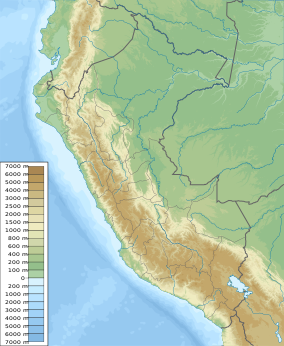| Pagaibamba Protection Forest | |
|---|---|
| Bosque de Protección Pagaibamba | |
| IUCN category VI (protected area with sustainable use of natural resources) | |
 Waterfall inside Pagaibamba Protection Forest Waterfall inside Pagaibamba Protection Forest | |
 | |
| Location | Cajamarca |
| Coordinates | 6°24′53″S 79°04′03″W / 6.4147°S 79.0675°W / -6.4147; -79.0675 |
| Area | 8.0247 sq mi (20.784 km) |
| Established | June 19, 1987 (1987-June-19) |
| Governing body | SERNANP |
| Website | Bosque de Protección Pagaibamba |
Pagaibamba Protection Forest is a protected natural area in the region of Cajamarca, Peru. The area was declared a protection forest in order to preserve the water supply of surrounding towns, preserve the water cycle of the area, protect road infrastructure and protection of soils by preventing erosion.
History
The Pagaibamba Protection Forest was established on June 19, 1987.
Geography
This protection forest is located in the district of Querocoto, Chota Province, Cajamarca. It covers an extension of 2,078.38 hectares (8.0247 sq mi) and protects a mountainous area dissected by small creeks. Elevations in the area are between 2300 and 2800 m.
Climate
Mean annual temperatures have a maximum of 10,9 °C and a minimum of 6,5 °C. The annual average precipitation has a maximum of 1,722 mm and a minimum of 834 mm.
Ecology
Flora
According to the Holdridge life zones classification, the vegetation type is a wet tropical mountain forest. Among the plant species reported in the area are: saucecillo (Podocarpus sp.), roble amarillo (Ocotea sp.), lanche (Myrcianthes sp.), suro (Chusquea sp.), queñual (Polylepis sp.), aliso (Alnus acuminata), palm trees, tree ferns, etc.; growing in association with tall grasses.
Fauna
Mammals reported in the forest include: the spectacled bear, the puma, the white-tailed deer, the Andean fox, the montane guinea pig, the mountain tapir, the tapeti, the pacarana, etc. The rodent Thomasomys pagaibambensis is only known from the forest.
Among the birds present in the area are: the razor-billed curassow, the Andean guan, the Andean condor, etc.
The frog Pristimantis chimu is reported in this area.
Activities
Nature watching, trekking and scientific research are the main activities in the area.
Environmental issues
Deforestation is threatening the forest's area of extension. In late 2016, Pagaibamba was one of several protected areas in northern Peru affected by human-caused wildfires. These fires were caused by slash-and-burn agricultural practices that went out of control coupled with drought. The burning of forests to open land for crops is considered illegal in Peru.
References
- ^ "De Pagaibamba – Servicio Nacional de Áreas Naturales Protegidas por el Estado". www.sernanp.gob.pe (in European Spanish). Retrieved 2017-05-11.
- ^ "BOSQUE DE PROTECCIÓN DE PAGAIBAMBA" (in Spanish). MINCETUR. Archived from the original on 2017-07-28. Retrieved 2017-05-11.
- Weigend, Maximilian; Rodríguez, Eric; Arana, César (2005). "Los bosque relictos del noroeste de Perú y del suroreste de Ecuador". Revista Peruana de Biología. 12 (2): 189. doi:10.15381/rpb.v12i2.2390.
- ^ Jiménez, Carlos F.; Quintana, Heidi; Pacheco, Víctor; Melton, Derek; Torrealva, Javier; Tello, Guillermo (2010). "Camera trap survey of medium and large mammals in a montane rainforest of northern Peru". Revista Peruana de Biología. 17 (2): 191–196. doi:10.15381/rpb.v17i2.27. ISSN 1727-9933.
- Pacheco, Víctor Raul; Ruelas, Dennisse (2023-06-21). "Systematic revision of Thomasomys cinereus (Rodentia: Cricetidae: Sigmodontinae) from northern Peru and southern Ecuador, with descriptions of three new species". Bulletin of the American Museum of Natural History. 461: 1–72. doi:10.1206/0003-0090.461.1.1.
- Venegas, Pablo J.; Duellman, William E. (2012-03-28). "Two syntopic new species of the Pristimantis orestes Group (Anura: Strabomantidae) from northwestern Peru". Zootaxa. 3249 (1): 47–59. doi:10.11646/zootaxa.3249.1.5. ISSN 1175-5334.
APPENDIX. Specimens examined. Pristimantis chimu: PERU: Cajamarca: Bosque de Protección de Pagaibamba, 3000 m
- ^ "'Out of control' wildfires damage protected areas in northern Peru". Mongabay Environmental News. 2017-01-17. Retrieved 2018-10-27.
- ^ "MAAP #52: Update – Fires Degrade 11 Protected Areas in northern Peru". MAAP. 2017-01-11. Retrieved 2018-10-27.
- "Forest fires affecting 10 regions, 4 natural zones in Peru". Fox News Latino. 2016-11-23. Retrieved 2018-10-27.
External links
- Bosque de Protección Pagaibamba. Official site (in Spanish).
- Bosque de Protección Pagaibamba. Official map.
- Bosque de Protección Pagaibamba. Profile at Protectedplanet.net
| Protected areas of Peru | |
|---|---|
| National Parks | |
| National Sanctuaries | |
| Historic Sanctuaries | |
| National Reserves | |
| Wildlife Refuges | |
| Landscape Reserves | |
| Communal Reserves | |
| National Forests | |
| Protection Forests | |
| Game Reserves | |
| Reserved Zones | |
| Regional Conservation Areas | |
| Private Conservation Areas | |